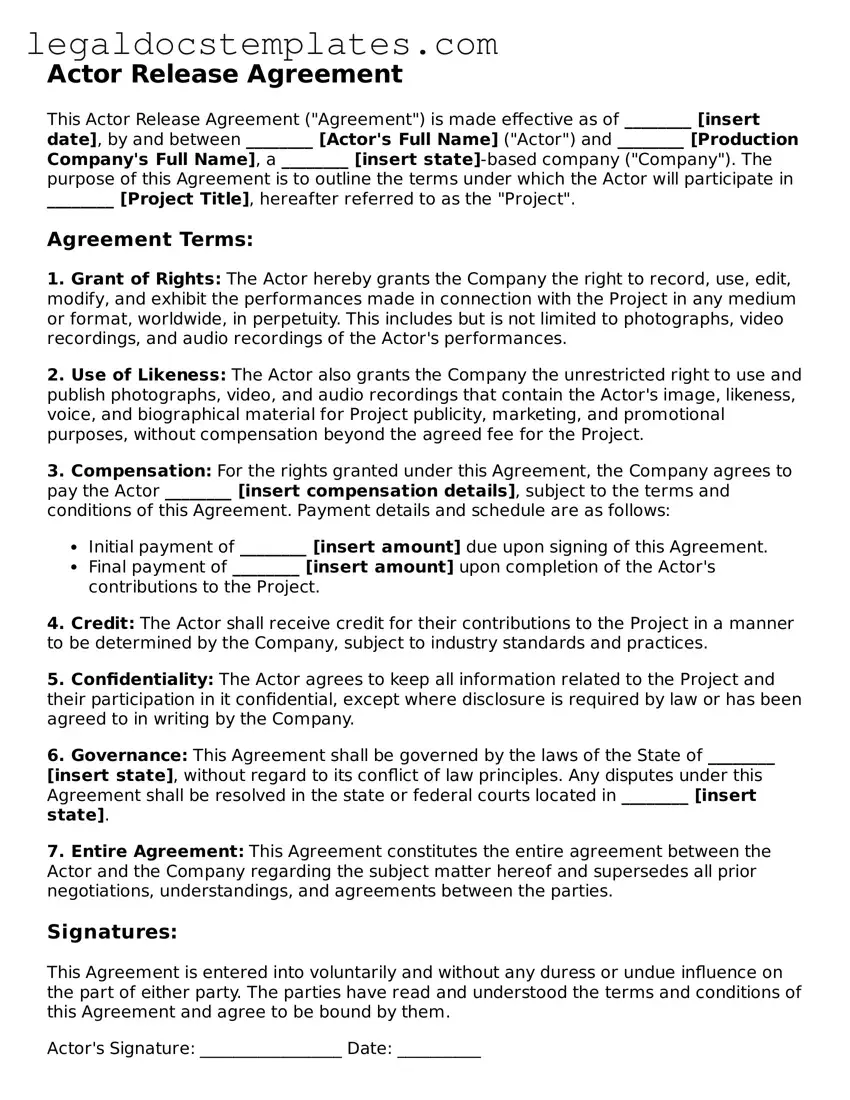Actor Release Agreement
This Actor Release Agreement ("Agreement") is made effective as of ________ [insert date], by and between ________ [Actor's Full Name] ("Actor") and ________ [Production Company's Full Name], a ________ [insert state]-based company ("Company"). The purpose of this Agreement is to outline the terms under which the Actor will participate in ________ [Project Title], hereafter referred to as the "Project".
Agreement Terms:
1. Grant of Rights: The Actor hereby grants the Company the right to record, use, edit, modify, and exhibit the performances made in connection with the Project in any medium or format, worldwide, in perpetuity. This includes but is not limited to photographs, video recordings, and audio recordings of the Actor's performances.
2. Use of Likeness: The Actor also grants the Company the unrestricted right to use and publish photographs, video, and audio recordings that contain the Actor's image, likeness, voice, and biographical material for Project publicity, marketing, and promotional purposes, without compensation beyond the agreed fee for the Project.
3. Compensation: For the rights granted under this Agreement, the Company agrees to pay the Actor ________ [insert compensation details], subject to the terms and conditions of this Agreement. Payment details and schedule are as follows:
- Initial payment of ________ [insert amount] due upon signing of this Agreement.
- Final payment of ________ [insert amount] upon completion of the Actor's contributions to the Project.
4. Credit: The Actor shall receive credit for their contributions to the Project in a manner to be determined by the Company, subject to industry standards and practices.
5. Confidentiality: The Actor agrees to keep all information related to the Project and their participation in it confidential, except where disclosure is required by law or has been agreed to in writing by the Company.
6. Governance: This Agreement shall be governed by the laws of the State of ________ [insert state], without regard to its conflict of law principles. Any disputes under this Agreement shall be resolved in the state or federal courts located in ________ [insert state].
7. Entire Agreement: This Agreement constitutes the entire agreement between the Actor and the Company regarding the subject matter hereof and supersedes all prior negotiations, understandings, and agreements between the parties.
Signatures:
This Agreement is entered into voluntarily and without any duress or undue influence on the part of either party. The parties have read and understood the terms and conditions of this Agreement and agree to be bound by them.
Actor's Signature: _________________ Date: __________
Company's Representative Signature: _________________ Date: __________
